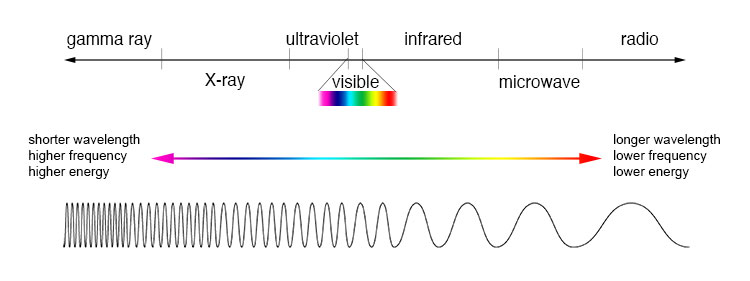Scribe Post: Juliette Ovadia
Agenda
Today, Mrs. Friedmann checked in our homework from over the weekend, the Light and Energy worksheet. We did a short activity on the line spectrum. Then, we quickly reviewed the notes we took in class on Friday and took more notes on the Electromagnetic Spectrum, Bohr's Model and beyond and Orbitals. We did not finish the notes, stopping at n=2 in the table, however these are posted on moodle.
"Magic" Glasses and Hydrogen
In our notes, we learned about the electromagnetic spectrum, not just visible light.
When you shine white light from a light bulb through a prism, you can see all the types of visible light, ROY G BIV, and the long wavelengths (ROY) bend less while the short wavelengths (BIV) bend more.
Glasses were handed out that allowed us to see the visible light (colors) from the lighting in the room. Then, using a gas discharge tube containing hydrogen, an electric charge was sent through it like a neon sign. The light from hydrogen was shined through the prism, and with our glasses we could see the hydrogen's "line spectrum", only red, blue, indigo, and violet-- just four colors could be seen.
This is called the LINE SPECTRUM, the "element's fingerprint". Every element has a different line spectrum, as shown by Bohr's complicated mathematical equations.
The "They Might Be Giants" video we watched about ROY G BIV is below.
Notes
The image in the notes below shows that an electron goes from ground state to a high energy state, falls back to the ground state, and to get rid of the energy releases a specific wavelength (line spectrum), not the entire rainbow. This is because the electron must jump a SPECIFIC distance, therefore when it falls it releases a specific wave of energy.
On the Bohr Model and Beyond Notes, it's important to remember that wavelengths of light released depend on how many level the electron jumps and falls.
Some other things to understand is that Newtonian physics works beautifully for large, everyday things. But get really small or really big and Newtonian physics breaks down, and you need a new kind of physics, which is Quantum Mechanics.
Orbital: wave function, area where you will probably find an electron
Heisenberg "uncertainty principle": you cannot know an electron's position and momentum at the same time. One must assume for the electron to jump from energy level to energy level it must simultaneously disappear from its position and reappear in another position, which is only possible on the quantum level, and scientists still do not totally understand how or why this happens.
Homework:
2 Webassigns (Due tonight at 11:59 PM)
Quantum Numbers Sheets (2)
Make sure all notes are copied into notebook!
Homework:
2 Webassigns (Due tonight at 11:59 PM)
Quantum Numbers Sheets (2)
Make sure all notes are copied into notebook!
ROY G BIV Video
The next scribe is Valerie K.




Nice Job! I love how you included everything from today including the video! Also very nice pictures which included the notes! Lastly, you made it nice and organized, so it's easy to follow. :) Keep on working hard!
ReplyDeletegood job, this was really helpful!
ReplyDeleteGood job! The images were helpful.
ReplyDelete